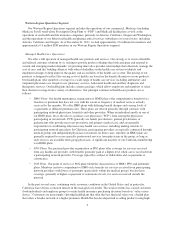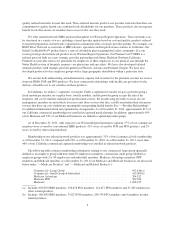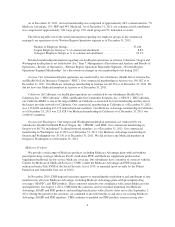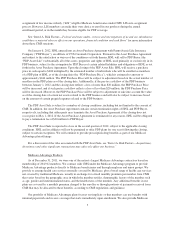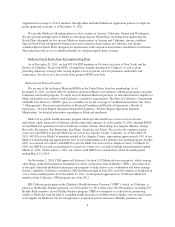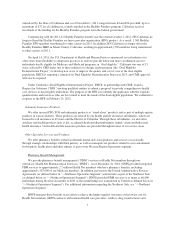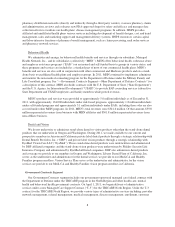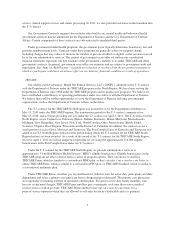Health Net 2011 Annual Report Download - page 14
Download and view the complete annual report
Please find page 14 of the 2011 Health Net annual report below. You can navigate through the pages in the report by either clicking on the pages listed below, or by using the keyword search tool below to find specific information within the annual report.Medicaid businesses transitioned to other United products to the extent the value of such members, based upon a
formula set forth in the Stock Purchase Agreement, exceeded the initial minimum payment of $60 million
(referred to as contingent membership renewals). This membership transition was completed on July 1, 2011. In
connection with the contingent membership renewals, we recorded as an adjustment to the loss on sale of the
Northeast health plan subsidiaries of $40.8 million for the year ended December 31, 2011 and $42.0 million for
the year ended December 31, 2010. Under the Stock Purchase Agreement, we were also entitled to 50 percent of
the profits or losses associated with the Acquired Companies’ Medicare business for the year ended
December 31, 2010 (subject to a cap of $10 million of profit or loss), and in the first quarter of 2011, we received
$7.4 million in connection with our portion of the profits associated with the Acquired Companies’ Medicare
business. The Medicare business was transferred to a United affiliate on January 1, 2011. We also administered
the Medicaid business of the Acquired Companies until it was transitioned to a United affiliate on May 1, 2010.
See “Item 1A. Risk Factors—Under the agreements that govern the Northeast Sale, we have retained
responsibility for certain liabilities of the acquired business, which could be substantial” for additional
information regarding the Northeast Sale and our Northeast Operations segment.
Provider Relationships
The following table sets forth the number of primary care and specialist physicians contracted either directly
with our HMOs or through our contracted participating physician groups (“PPGs”) as of December 31, 2011. We
have a number of physicians who are contracted providers for both HMOs and PPOs in our Western Region
Operations, as follows:
Primary Care Physicians (includes both HMO and PPO physicians) ........... 20,911
Specialist Physicians (includes both HMO and PPO physicians) .............. 100,933
Total ............................................................. 121,844
Under our California HMO and POS plans, all members are required to select a PPG and generally also a
primary care physician from within the PPG. In our other plans, including all of our plans outside of California,
members may be required to select a primary care physician from the broader HMO network panel of primary
care physicians. The primary care physicians and PPGs assume overall responsibility for the care of members.
Medical care provided directly by such physicians includes the treatment of illnesses not requiring referral, and
may include physical examinations, routine immunizations, maternity and childcare, and other preventive health
services. The primary care physicians and PPGs are responsible for making referrals (approved by the HMO’s or
PPG’s medical director as required under the terms of our various plans and PPG contracts) to specialists and
hospitals. Additionally, our tailored network products utilize a network that is smaller than our broader HMO
network but contains a comprehensive array of physicians, specialists, hospitals and ancillary providers. Certain
of our HMOs offer enrollees “open access” plans under which members are not required to secure prior
authorization for access to network physicians in certain specialty areas, or “open panels” under which members
may access any physician in the network, or network physicians in certain specialties, without first consulting
their primary care physician.
PPG and physician contracts are generally for a period of at least one year and are automatically renewable
unless terminated, with certain requirements for maintenance of good professional standing and compliance with
our quality, utilization and administrative procedures. In California, PPGs generally receive a monthly capitation
fee for every member assigned to it. The capitation fee represents payment in full for all medical and ancillary
services specified in the provider agreements. For these capitation fee arrangements, in cases where the capitated
PPG cannot provide the health care services needed, such PPGs generally contract with specialists and other
ancillary service providers to furnish the requisite services under capitation agreements or negotiated fee
schedules with specialists. Outside of California, most of our HMOs reimburse physicians according to a
discounted fee-for-service schedule, although several have capitation arrangements with certain providers and
provider groups in their market areas. A provider group’s financial instability or failure to pay secondary
12


